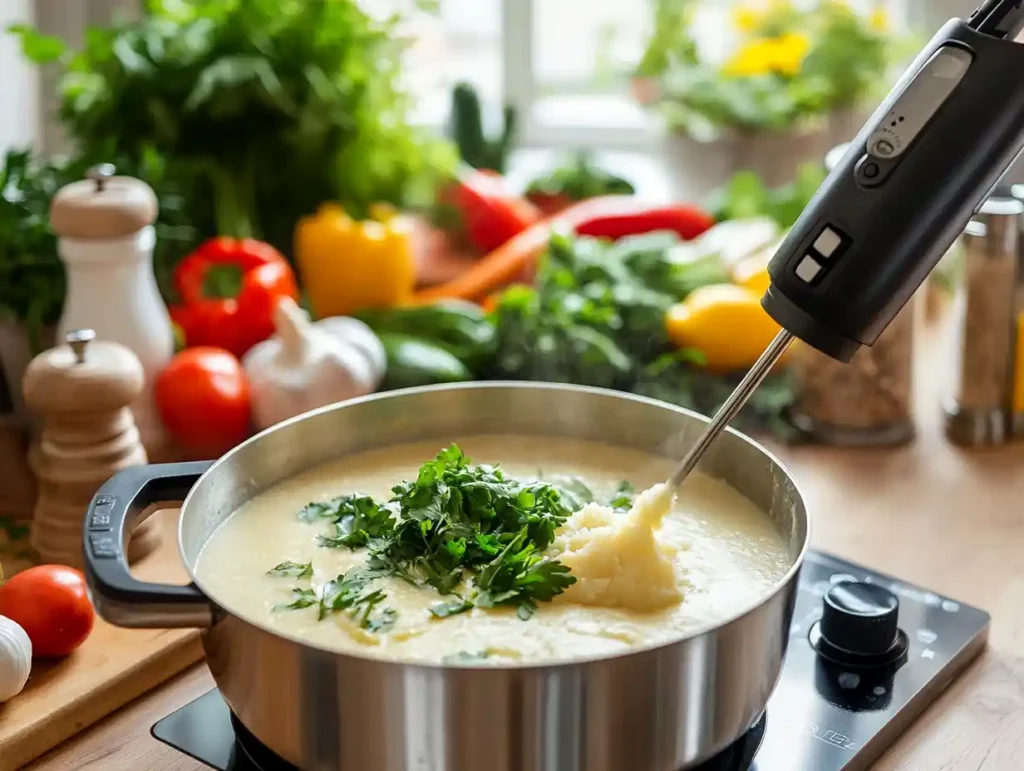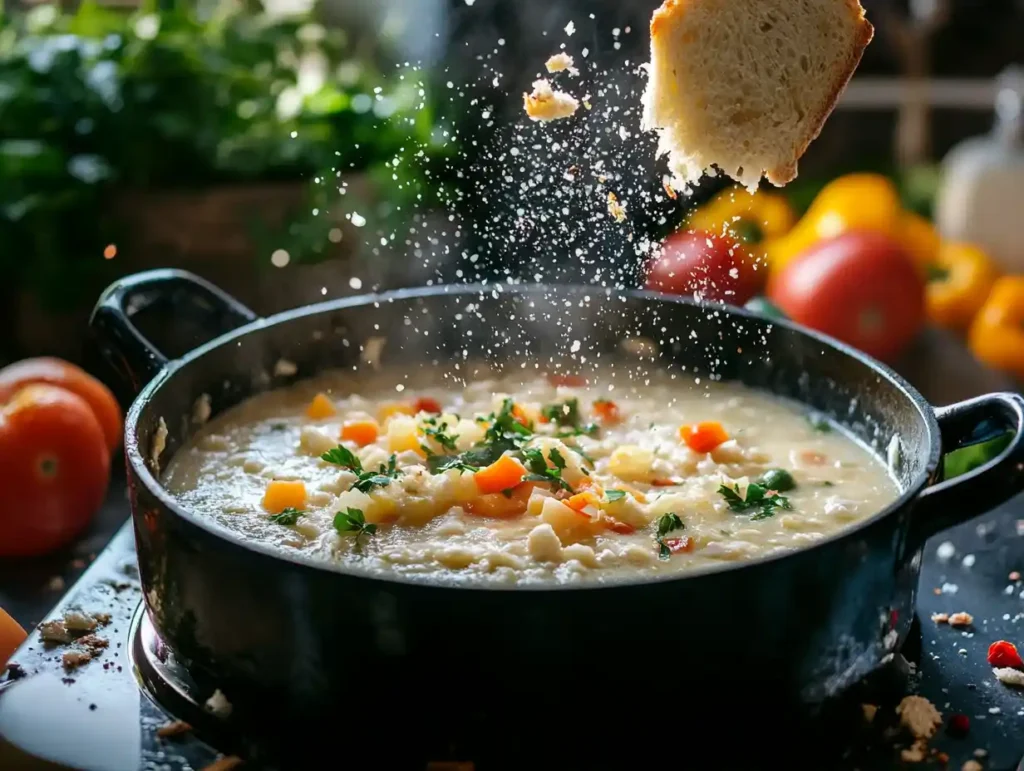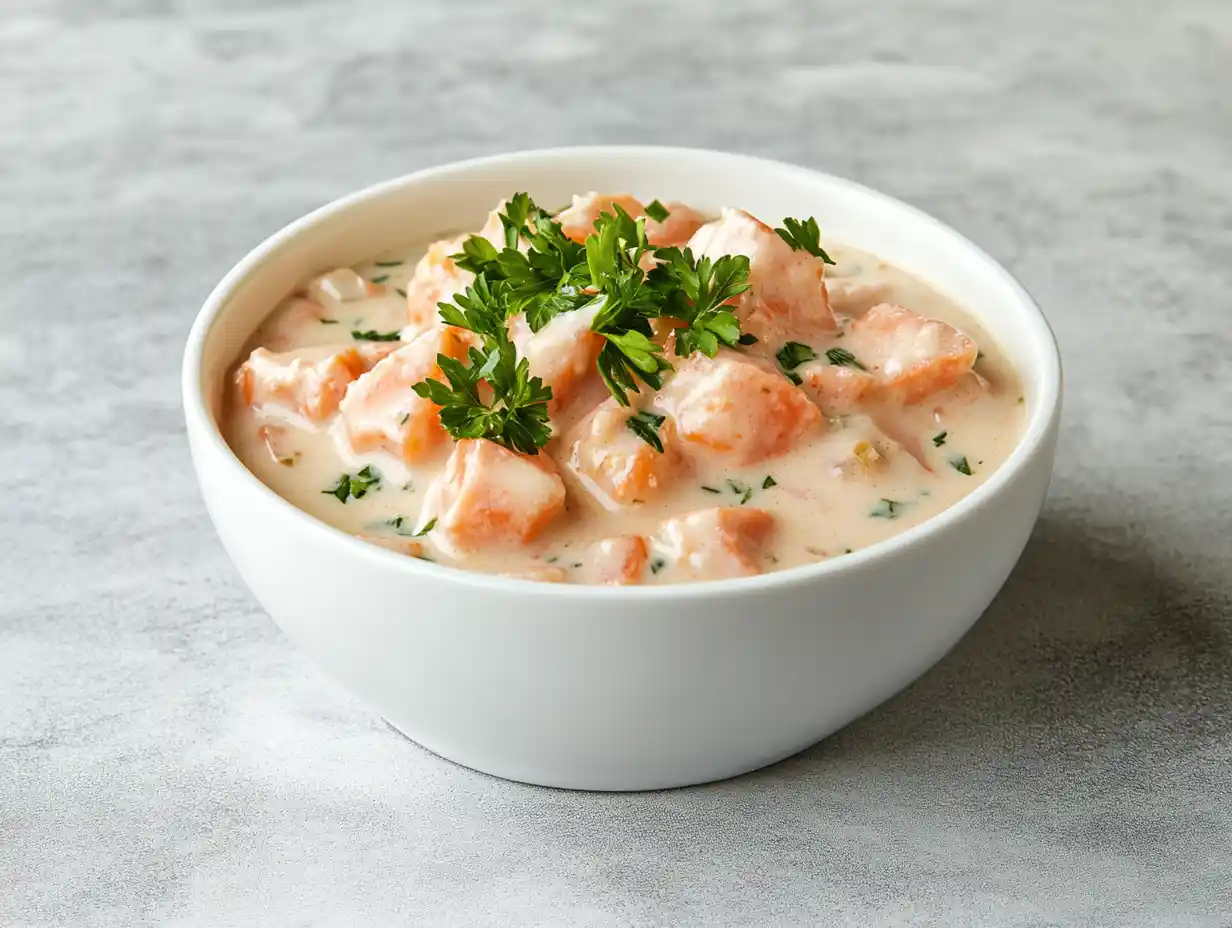Introduction
Chowder is a hearty, comforting soup celebrated for its creamy, velvety texture and rich flavor. Traditionally, cream plays a key role in achieving that luxurious consistency, but not everyone can or wants to use cream in their chowder. Whether you’re aiming to reduce fat and calories, accommodate dietary restrictions, or simply explore alternative methods, there are countless ways to thicken chowder without cream.
If you’ve ever wondered how to thicken chowder without cream, the good news is that you don’t need to sacrifice flavor or texture. From cornstarch and mashed vegetables to innovative cream-free chowder tips like plant-based milk or nut-based creams, these methods allow you to customize your chowder while keeping it thick and indulgent.
In this guide, we’ll dive into practical, creative, and healthy techniques to thicken chowder. You’ll learn how to use common pantry staples, natural ingredients, and even some surprising methods to create a rich and satisfying dish. Whether you’re making seafood chowder, corn chowder, or a hearty vegetable version, these tips will ensure a delicious outcome every time.
Why Avoid Cream in Chowder?
While cream is a traditional ingredient in chowder recipes, there are several compelling reasons to consider alternatives. Whether due to health concerns, dietary restrictions, or a desire to experiment with flavors, skipping cream can lead to delicious and satisfying results.
Dietary Restrictions
One of the main reasons to avoid cream in chowder is to accommodate dietary restrictions. For individuals who are lactose intolerant, consuming cream can cause discomfort or digestive issues. Additionally, those following vegan or dairy-free diets need alternatives that align with their lifestyle. By using substitutes like plant-based milk or starchy vegetables, you can cater to a wider audience without sacrificing taste.
Health Considerations
Chowder made with heavy cream can be calorie-dense and high in fat. For those aiming to reduce their calorie intake or maintain a heart-healthy diet, thickening chowder without cream is a practical choice. Substitutes such as puréed vegetables or low-fat dairy alternatives provide texture and richness without the extra calories or saturated fat.
Enhancing Natural Flavors
Using cream can sometimes overshadow the natural flavors of the other ingredients in chowder, such as seafood, vegetables, or herbs. By opting for alternative thickening methods, you allow these flavors to shine. Techniques like blending potatoes or using cornstarch can maintain the integrity of the chowder’s base ingredients while achieving the desired consistency.
Cornstarch Slurry for Thickening
Cornstarch is a versatile and effective thickening agent that works well in chowder. This pantry staple is easy to use and provides a smooth, creamy texture without the need for cream.
What Is Cornstarch Slurry?
A cornstarch slurry is a mixture of cornstarch and a liquid, typically water or broth. The slurry is added to the chowder to thicken it as it cooks. Cornstarch is a popular choice because it’s flavor-neutral and doesn’t alter the taste of the dish.
Step-by-Step Process to Prepare a Cornstarch Slurry
- Measure Ingredients: For every cup of chowder, combine one tablespoon of cornstarch with one tablespoon of cold water or broth.
- Mix Thoroughly: Stir the cornstarch and liquid in a small bowl until it forms a smooth, lump-free mixture.
- Incorporate into Chowder: Slowly pour the slurry into the simmering chowder, stirring constantly to distribute evenly.
- Cook to Thicken: Allow the chowder to cook for a few minutes. The cornstarch will activate as the chowder heats, creating a thicker consistency.
Tips for Using Cornstarch Effectively
- Always mix the cornstarch with cold liquid before adding it to avoid clumps.
- Use small amounts initially; you can always add more slurry if needed.
- Avoid overcooking after adding the slurry, as prolonged heat can break down the cornstarch and thin the chowder.
Flour-Based Methods
How to Use a Roux to Thicken Chowder Without Cream
A roux is a classic thickening agent made by cooking equal parts of flour and fat, usually butter or oil. To use a roux for chowder, heat your fat in a pan, stir in the flour, and cook it for a minute or two to remove the raw taste. Slowly whisk the roux into your chowder, ensuring there are no lumps. This method creates a velvety texture while enhancing the dish’s richness.
Using a Flour Slurry to Thicken Cream-Free Chowder
If making a roux seems complicated, a flour slurry offers a quick alternative. Mix flour with a small amount of cold water or broth until smooth. Stir this mixture into the simmering chowder, cooking it for a few minutes until it thickens. This approach is fast and doesn’t require extra cooking steps.
Effects on Flavor and Texture
Using flour can slightly alter the flavor of your chowder, adding a mild, nutty undertone. To keep the dish balanced, adjust your seasoning. The texture becomes creamy and thick, but be cautious—too much flour can make it gummy. Start small and add more as needed.
Starchy Vegetable Purées

Examples of Starchy Vegetables
Starchy vegetables like potatoes, sweet potatoes, and cauliflower work wonders as natural thickeners for chowder. These vegetables not only enhance the texture but also add depth and flavor to the dish. Potatoes are a classic choice, while sweet potatoes add a hint of sweetness, and cauliflower keeps things light and subtle.
Blending Techniques for Smooth Consistency
Cook the starchy vegetables until they are soft enough to mash or blend. Use an immersion blender directly in the chowder pot for convenience. Alternatively, blend the vegetables separately with a little broth and stir the purée back into the chowder. This method ensures a smooth, lump-free consistency.
Maintaining the Flavor Profile
To keep your chowder’s signature taste intact, avoid overloading it with puréed vegetables. Use just enough to achieve the desired thickness. Potatoes and cauliflower are particularly neutral and won’t overpower the seafood or other main ingredients. Sweet potatoes, while flavorful, should be used sparingly to avoid masking the chowder’s core flavors.
Mashed Ingredients as Thickeners
Thickening Chowder Without Cream Using Mashed Potatoes or Beans
Mashed ingredients are a quick and effective way to thicken chowder. Leftover mashed potatoes or canned white beans work exceptionally well. Both options add a creamy texture without requiring additional cooking.
Incorporating Mashed Ingredients Properly
To incorporate mashed ingredients, mix them with a small amount of warm broth before adding them to the chowder. This step ensures they blend smoothly without forming lumps. Stir the mixture into the pot and simmer for a few minutes to allow the flavors to meld.
Pros and Cons of This Method
Using mashed potatoes or beans adds creaminess and fiber, making your chowder more filling and nutritious. However, the method can slightly thicken the flavor profile, so adjust seasonings as needed. For example, adding a pinch of salt or a splash of vinegar can balance the richness.
Alternative Dairy Substitutes
Using Plant-Based Milk or Cream Substitutes
Dairy-free alternatives like almond milk, oat milk, or coconut milk can easily replace cream in chowder. These options offer a creamy texture while accommodating lactose-intolerant or vegan diets. Oat milk has a neutral taste, almond milk is slightly nutty, and coconut milk brings a mild sweetness that pairs well with certain chowders.
How Nut-Based Creams Add Richness
Nut-based creams, such as cashew cream, provide a rich and velvety texture. To make cashew cream, soak raw cashews in water, then blend them until smooth. Add this to your chowder to mimic the luxurious mouthfeel of heavy cream. This method is especially popular for vegan recipes.
Balancing Flavor When Substituting Dairy
While dairy substitutes thicken and enrich chowder, they can alter the flavor. Coconut milk, for instance, adds sweetness that might not complement all chowder types. To balance flavors, use savory seasonings like garlic, thyme, or smoked paprika. Additionally, a splash of lemon juice can cut through sweetness and enhance the dish’s overall taste.
Bread or Cracker Methods

Crumbling Bread or Crackers into Chowder
Bread and crackers are handy for thickening chowder and are often already available in the kitchen. Crumble them directly into the pot, then stir to integrate. The bread or crackers will absorb liquid and break down, naturally thickening the chowder.
Achieving Desired Texture and Consistency
Start with small amounts, as bread and crackers thicken quickly. For a smoother texture, use an immersion blender after the bread has softened. This step ensures that the chowder maintains its creamy, cohesive consistency without clumps.
Best Types of Bread or Crackers to Use
Rustic breads like sourdough or French bread work particularly well due to their dense texture. For crackers, unsalted varieties are ideal to avoid oversalting the dish. Oyster crackers or plain saltines are common favorites that complement the flavors of chowder.
FAQs
What are the best plant-based alternatives to cream in chowder?
Oat milk and cashew cream are excellent substitutes. They both provide creaminess without overpowering the chowder’s flavor.
Can you thicken chowder without changing its flavor?
Yes, methods like using cornstarch or potato purée preserve the original taste of the chowder.
How do chefs maintain chowder consistency?
Chefs often use a combination of methods, such as a roux, vegetable purées, or mashed ingredients, to control the thickness precisely.
Are there gluten-free options for thickening chowder?
Absolutely! Cornstarch, potato purée, or mashed beans are all excellent gluten-free thickening choices.
Can I freeze chowder made with alternative thickeners?
Yes, but avoid freezing chowder thickened with flour, as it may separate when reheated. Starchy vegetables hold up better in the freezer.
How much thickener should I use?
It depends on the method. Start with small amounts, taste frequently, and adjust until you reach your desired thickness.
Conclusion
Thickening chowder without cream isn’t just a practical solution for dietary restrictions—it’s also an opportunity to experiment with exciting textures and flavors. From the simplicity of cornstarch and flour-based methods to the creativity of vegetable purées and mashed ingredients, these techniques offer endless possibilities for crafting a dish that’s tailored to your preferences.
For those looking to keep it light and healthy, options like cornstarch or starchy vegetable purées provide a creamy consistency without the extra calories of cream. If you’re catering to a vegan or dairy-free audience, nut-based creams and plant-based milks offer richness while complementing the dish’s natural flavors. Even traditional methods, like incorporating bread or crackers, can be reimagined to add unique textures and a rustic charm.
When choosing the right thickening method, consider the type of chowder you’re making. A seafood chowder might benefit from the neutral profile of potatoes, while a vegetable-based chowder pairs well with the slightly nutty flavor of cashew cream. Balancing these choices with your desired texture ensures a perfect outcome every time.
Ultimately, the beauty of chowder lies in its versatility. With or without cream, you can create a hearty, flavorful dish that’s comforting and delicious. So, embrace the challenge of thickening chowder without cream, and let your creativity shine in the kitchen. Your efforts will be rewarded with a bowl of chowder that’s not only rich and satisfying but also perfectly suited to your lifestyle and preferences.
To discover more chowder-making tips, explore Pepperoni pinwheels for a detailed understanding. You might also enjoy our guide on Easy Banana Bread Using Bread Machine for a clear comparison. For further inspiration, visit Can you freeze Christmas truffles? and elevate your soup-making skills!

